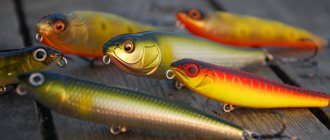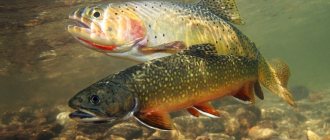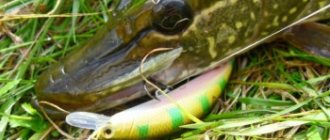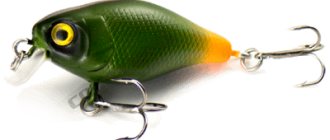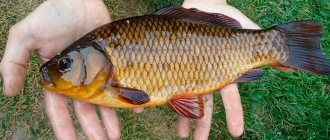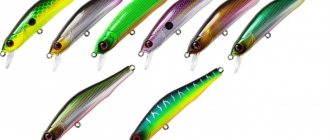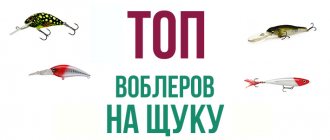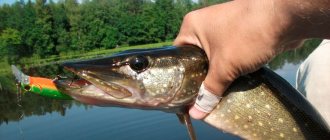The most long-awaited season for any spinning player is coming. Autumn is a time of starry nights, golden leaves on the water, foggy mornings with drizzle... and trembling hopes of meeting a long-awaited trophy.
In this article I will try to give basic tips that will help a novice spinning fisherman realize his long-time dream of catching a trophy specimen! But even an experienced fisherman will probably have something to learn.
It’s no secret that catching an old, “smart” fish that has not been possible for other fishermen for decades is an extremely difficult task. Not only are there very few such individuals in the reservoir, but it is also very difficult to provoke “wise” fish to bite. To some extent, you must be lucky; many factors must come together for those long-awaited moments of fighting a real monster to come.
Hope for luck, but don't be bad yourself. This should describe the main principle that every trophy hunter should follow. If you don’t understand where to look for a large predator, don’t know what to catch it with, what wires to use, then your already not high chances will be reduced to 0.
Therefore, let's start in order, first of all you need to understand where the largest individuals live. After all, there is no point in dipping the bait into the water if you have not guessed the place where the predator is staying and feeding.
Where to look for trophy pike?
No matter how simple it may sound, the largest individuals (and we are talking about pike from 8 kg) stay close to the deepest places in the reservoir. Study the navigation directions and modern cartography. A promising place for catching a trophy predator implies the presence of a hole nearby with maximum depths for a given water area.
There may be quite a few such places in a reservoir, but not all of them attract large predators. “Mothers” choose the most convenient areas for their habitat and feeding, usually these are:
- Irrigation outlets from deep channel holes where local snags are present;
- The edges, from which the main jet is repelled, slow down, or a reverse flow is formed. The presence of heterogeneous terrain in such places will be a weighty argument;
- Deep fairway slopes into the main channel, where the flow slows down for some reason, there are rock outcrops, boulders at the bottom, old technological debris, submerged objects that serve as both ambushes for predators and protect against strong heat;
- Old riverbed snags. You should know that a large, dense snag is not the most promising place. Small, local snags and a couple of flooded trees work much better, rather than a continuous underwater forest;
- In reservoirs, promising places are the vicinity of flooded villages and buildings. Usually in such locations there is a lot of heterogeneous terrain. The mouths of old rivers are usually also promising for searching. Such areas can be detected on the map before flooding;
- Another important factor is the presence of permanent white fish nearby: bream, ide, roach. Cyprinids often stand in places where there are colonies of shells and pearl barley.
In autumn, flocks of leucorrhoea accumulate in wintering pits. There are not very many such pits on the river, because several important factors need to coincide in order for a pit to become a “wintering place.” It is worth looking for large pike in the fall near such holes.
Remember one more observation from your own practice. There are a lot of snags on the river, but not all of them are worth counting on catching a trophy. Coastal snags with depths of up to 5-6 meters are mainly favored by pike weighing up to 5 kg; the largest individuals graze in the snags closer to riverbed dumps and irrigation areas.
As I have already noted, you should not focus on large, extended rubble of snags, and think that the more extensive they are, the better - this is not so. At a minimum, it will be very difficult for you to find fish in them, because... it “spread” over a wide area. While a small snag area of a few square meters will contain a high concentration of predators, and it will be much easier to fish this area.
Remember also one more important point. After catching a large specimen from a promising point, another pike will soon take over. A holy place is never empty. Pike have a lot of competition for the most convenient areas of the reservoir for hunting, and a good place will not be empty for a long time. Sometimes on a really steep, good point there can be several rather large pikes.
And the most important and simple rule is: “The further into the forest, the more firewood.” The chances of catching a trophy predator increase with distance from civilization. Within the metropolis and its surrounding areas within a radius of 50-70 km, encounters with trophy fish are rare. Increased fishing pressure in recent years has left fewer and fewer chances of encountering “crocodiles” near cities.
Release the caught trophies, give them life so that next time they can please you and other fishermen with bright moments of an unforgettable fight.
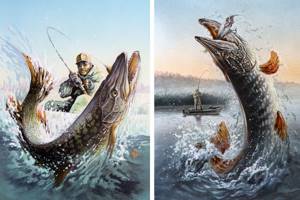
At what time of year do you catch pike with a spinning rod?
When and where to catch pike? The second half of spring and June are considered one of the most favorable periods. Pike spawns early (sometimes before the ice begins to melt), and already about 7-10 days after the end of spawning, during which the fish are “sick,” the intense biting season begins.
On hot summer days, the best time for fishing for pike is considered to be early morning and late evening, but in cool rainy or cloudy weather the fish bite well throughout the whole day. At the same time, pike fishing with a spinning rod is carried out mainly in shallow water, near the coastal zone.
Often intense biting is observed in thickets of perennial aquatic plants and water lilies. Fishing with a spinning rod for pike in the fall has some peculiarities. After the reservoirs cool down, the fish traditionally move to deep water. At the same time, a good pike bite in the fall is also possible in fairly shallow areas of lakes and rivers - this picture is mainly observed in large bodies of water with thick algae and the absence of a large number of small fish.
Many fishermen successfully catch pike with spinning rods in October and November before freeze-up, however, mainly on those days when there is sunny, clear weather with an increasing temperature.
When does the autumn pike zhor come?
It’s not enough to find a promising place; you also need to figure out the best time for pike activity. After a hot, sultry summer, pike begin to actively feed. When the water level in the river drops, the oxbow lakes dry up, the channels dry up, and the first cold snap sets in - this is the signal to start trophy hunting! In our region, this is usually the end of July - the beginning of August, but recently the calendar is increasingly moving closer to September.
Not only is a large pike more difficult to tease and provoke to bite, it also rarely goes out hunting. Its metabolism is slower, compared to 1-3 kg pullets, which are ready to attack anything that floats nearby. Large pike feed on kilogram-sized fish, after swallowing which they return to their stopping place and digest the prey for quite a long time, without reacting to anything else at this time.
You should know that maximum activity in pike occurs when the water temperature drops to approximately 15 degrees ; the fish's satiety instincts turn on before a long winter - this leads to real gluttony. The active phase of which continues as the water cools to 8 degrees . During this period, your chances of meeting a trophy crab increase.
In autumn, the predator feeds throughout the day. On clear days, it makes no sense to get up early and go to the reservoir at dusk, hoping for an early exit of the pike, it is reckless. Rather, the first exit begins when the sun has already illuminated the pond with its rays, the second - from about 10 to 12 noon. In the evening, the start of departure can be expected around 18:00 and just before sunset. For different bodies of water, and especially weather conditions, exit hours may vary.

Fishing is interesting in December and in open water, if there are such places
At this time we were fishing with a jig, and foam rubber served as bait. Fishing was carried out only from the bottom, with step-by-step retrieval. Let us note on our own that we fished with both braid and monofilament. In both cases, especially if there is a “good frost”, the rings freeze over, because the cord drags water along with it. To some extent, various impregnations help, but this is not a panacea. Well, with braid you feel the bite better, but the fishing line is cheaper, and if it gets ruined over the winter, it’s not such a shame for the amount spent on it.
December is an interesting time for pike fishing; you can approach the most interesting places from the ice, the main thing is that the ice holds, do not forget about safety precautions. Sometimes, in the excitement of the first ice, you want a lot, but...
The first ice for a fisherman is a lot of pleasant emotions, and pike responds very well to both live bait and artificial bait (though it will have to do). Well, winter is slowly coming into its own, and it’s already January...
A few words about gear for catching trophies
To catch trophy specimens, you will need reliable tackle - this is an axiom. Often it arrives only after the first “mother” has been drained right next to the boat due to a bent Chinese carabiner, a broken hook or an incorrectly adjusted clutch.
Remember a few simple rules that will allow you not to lose your treasured trophy:
- Do not use unnecessary fittings. No fasteners, swivels or carabiners for easy changing of bait. Only a 30-40 cm string tied directly to the cord.
- No fluorocarbon when it comes to old “grandma’s” teeth, only steel/tungsten - only hardcore.
- Only high-quality reliable hooks from trusted brands. Other “crocodiles” click once or twice.
- Find a good cord that will not “shag” and rub against snags and shell rock after 5 wires - this is a common and annoying cause of failure.
- Use “Heavy” class rods, which will allow you not to fall through when hooking, adequately cope with powerful jerks, and allow you to have good control over a large bait in a strong heat.
- A Shimano 4000 class reel is definitely best for this style of fishing.
- Finally, buy a reliable, large landing net, not a butterfly net. And teach your partner how to hook the fish correctly.
Before the first cast, correctly adjust the drag on the reel so that it allows you to catch the fish at a long distance the first time, and does not overtighten it, extinguishing the first powerful jerks.

Lay out the landing net in advance so that there are no offensive dreams later, when the “mother” took a short bite right under the boat, and the partner hesitated - this often happens.
Of course, catching a trophy from the shore is much more difficult, so you will need a boat and at least a simple echo sounder (not a depth gauge).
Set aside a week or two in your fall fishing calendar for a trip away from civilization, to remote places where meeting a trophy fish will be higher than a meteorite falling on your head on a clear August night 

Follow these simple rules, and your first treasured trophy will decorate the wall of your house with a photograph, and will not be regrettably seen in nightmares.
Tactics for catching pike in shallow water
The main object of fishing in shallow water bodies is fish that feed near the shore. Many fishermen prefer areas abundantly overgrown with aquatic vegetation: it is believed that this is the most successful solution for catching pike in shallow water. You can fish with almost any bait.
Traditionally, in shallow waters, pike are caught using jigs or spinning rods. The main rule of shallow water fishing is the successful presentation of a spinner or popper. In this case, you should start with close casts, since with a high degree of probability the fish may be in close proximity to the fisherman: a cast that is too long will simply scare it away.
Remember that casts must be as accurate as possible, even if their length is 30-40 meters (otherwise you may get caught on grass or snags).
Before catching pike, decide on the point from which you will cast the spinning rod and try to fish the entire accessible fishing area. In this case, you need to move as silently and carefully as possible, since fish that feed in shallow water react very sensitively to any external stimulus.
What bait should I use to catch big pike?
The classical method of catching large pike with a spinning rod is jig . This is what I highlight as the main technique for catching trophies. But what kind of bait does a large pike prefer?
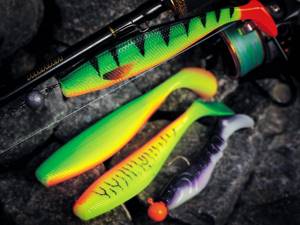
There were enough cases when trophies were caught with relatively small baits. But I believe that using large, bulky baits increases the chances of catching a really large specimen.
Use vibrating tails from 12 to 25 cm to catch the real “mother”. Moreover, such large rubber should be mounted only on a jig head, and not on a hinged mount with a Cheburashka. On a jig head, the bait plays more interestingly and “correctly” - this has long been noticed by experienced athletes.
The jig heads themselves are different. I recommend using heads in which the eye extends at 125 degrees, and the shape of the hook itself looks like the figure below. This contributes to a more reliable hooking and retention of fish when landing.
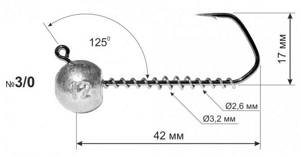
The second, not unimportant point is hooking, with one hook the fish is caught better, most often clearly under the upper jaw, and it is easier to cut and drive a single hook into a bony mouth than a double one.
If fishing takes place in a powerful snag, then yes - you can’t do without an offset hook. foam fish in snags - pike also actively attack them, sometimes no worse than silicone. The main thing is to choose the right foam. He should play well, wag his tail, and not fall “boringly.” Here you need to empirically select a good manufacturer, which will significantly increase the number of bites.
Streamers are another “tool” without which you shouldn’t start hunting for a trophy. If it were not for the constant, targeted fishing in places with hooks, and the high cost of these baits, they could be ranked 1-2 in terms of catchability next to large vibrotails. Many trophy pikes were caught on streamers after prolonged dipping of silicone at the same point. A recognized master of knitting streamers is Andrey Alferov, I use the streamer of his work.

Constantly changing bait and bait is another important nuance in successfully catching a trophy.

I also advise you to be patient - catching a trophy does not tolerate fuss, it is rather a methodical fishing of a promising place in which you are confident. Rearranging the boat at different angles, frequently changing the size, type, color of the bait and its wiring. This is not at all like when you catch 1.5-2 kg of active pike, ready to rush in the fall at everything that shines brightly and swims funny. This tactic is especially relevant in places with increased pressure. The most diligent and skillful fisherman wins.
I don’t see any point in recommending specific models and companies, there are a large number of manufacturers, they all make approximately the same silicone baits. It’s not the brand name that matters here, but the ability to position the boat correctly and present the bait in an interesting way.
Large pike are also successfully caught using jerks - large baits that are visually very similar to real fish and imitate their movements. This is really very exciting fishing - a separate type of fishing art, which begins with the painstaking development of an individual game for each bait... Not all places on the river are suitable for fishing in this way. It is especially difficult in the current, when accurately catching deep fairway drops and placing bait in the desired bottom horizon. This is an interesting, but not the most versatile fishing method, unlike jigs, so it is not very suitable for beginners. Let's not focus too much attention on it.
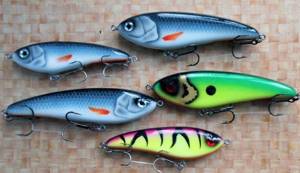
The spinner's box must contain an oscillating and rotating spoon .
Although, of course, they are inferior to jigs in fishing promising sites for trophy pike from a boat, they are quite well suited for fishing from the shore. Rotating spoons No. 4-6 Blue Fox and Mepps have long proven themselves in catching autumn pike. Another thing is that you can’t “rotate” them in snags, and it’s difficult to fish in great depths with the current. But they will also find their application in the skillful hands of a spinner.
Having installed the boat, you make 1-2 control casts of the tackle without live bait - determine how snagged the drop is (if the place is too “harsh”, slightly change the location of the boat) and what should be the optimal number of “olive” weights on the main line so that when retrieving touching the bottom was clearly recorded, and the weight of the load was minimal for the given fishing conditions.
Light loading is preferable - then the live bait is less injured when casting and “walks” more freely when retrieving. After the bite, when the predator drags the bait, the tackle should provide minimal resistance.
The preparation is complete, you put the live bait on the hook. The standard method of insertion is through the nostril. If the upper lip of the live bait is weak (bleak, small roach), then pierce the lower lip with a hook, and then remove the sting through the nostril. The second method is more reliable, but in this case the bait fish dies much faster.
Throw the tackle to the intended point. Try to fix the moment when the load touches the bottom (the line will weaken), select the extra line, wait 30-60 seconds for the bait to “come to its senses”, and start retrieving. It consists of sequentially performed very smooth pull-ups of the tackle by 0.3-1 meter and pauses of 10-60 seconds.
Reeling is lifting the rod from an inclined position (30-45 degrees relative to the surface of the water) to close to vertical. Then return the rod to an inclined position, take out the slack in the fishing line and wait a pause.
If you feel that the tackle is caught on something or there is a sharp jerk, pulling up should be stopped immediately. A jerk probably means that the fish has taken it, and this is the most common type of bite for most predators, including pike.
A grip in the form of a “hook” is less typical for pike (more common for pike perch), but is also not excluded. Even if the stop is not related to a bite, it is still useful to pause for about 1 minute. It is likely that the load rested against something like a step at the bottom, a stone, a snag, and a predator could be lying in ambush nearby.
When a bite occurs (or is suspected), the angler instantly loosens the line: the rod quickly moves forward, its tip lowers to the surface of the water. After this, the reel is removed from the brake (in the “inertia-free” one, the line handler arm is folded back).
The standard behavior of a pike after grabbing a live bait is well known: holding it in its teeth, it moves away 1-5 meters (sometimes more than 5 meters), then, standing still, turns the prey head first and swallows it.
Then the pike starts moving again. If it doesn’t stop after 3-5 meters, hook it. Until this moment, the fish should not experience any noticeable resistance to the tackle, so let the line come off freely, and it is advisable that it is pulled off the reel by the fisherman himself, and not by the predator.
The rig uses a single hook, and fishing is designed to completely swallow live bait. This leads to the main rule: it is better to hook later than earlier (within reason).
If the bite occurred on a large live bait, then there is no need to rush - a small pike will swallow it for a long time, perhaps in several stages. After hooking, fishing begins.
Pike is a fairly strong, fast and smart fish, so you must first tire it well - this applies to specimens weighing 1.5 kg. It is advisable for her to rise to the surface several times and take a breath of air.
At the same time, make sure that it does not start to accelerate sharply along the surface of the water: this means that the fish is going to “make a candle.” Contrary to what is written in the fishing literature, this ability is possessed not only by small, but also by large individuals (up to 4 kg inclusive).
A “candle” can be prevented if you manage to deflect the fish from a straight path with a strong movement of the rod to the side. But if the fish does jump out, you need to immediately release the tension of the fishing line (move the rod forward, lowering its tip into the water).
In addition, you should not let the pike go under the boat or put the fishing line under the rope going to the load, so the initial stages of fishing are best carried out at a sufficient distance (10 meters or more).
After the fish is taken, place it on the kukan and cut off the leash. If the hook is in the mouth, it can be easily removed by grasping the curve of the hook with large tweezers or a special clamp and pulling the leash through the soft tissue, like thread behind a needle.
If the hook ends up in the throat or esophagus, then it is better to leave it there until gutting. Pike with leashes sticking out of their throats lived with me on kukans with long cords for up to 6 days. And this is not the limit, since after such a long stay “on a leash”, they became even more frisky and aggressive.
Live bait used for fishing in this way must have a strong upper lip; withstand at least three casts without losing mobility, be attractive and noticeable to pike (weigh more than 30 g, have a length of 8-18 cm and, preferably, light color).
For the rivers of southern Russia, according to all the listed parameters, the best live bait is white (silver) crucian carp. It is extremely durable, can easily withstand up to 30 long casts, and actively “works” when retrieved. In addition, the largest specimens of “pit” pike are often caught on white crucian carp of quite impressive size.
In general, for fishing in the pit area, large baitfish are better than small ones. Even small pike (1-2 kg) show a clear preference for live bait weighing more than 80 g.
In second place after silver crucian carp is rudd. The vast majority of pike I caught using the method I described were caught using rudd.
In southern reservoirs, this fish is quite easy to catch using a light float rod in the upper layers of water near grass bushes, thickets of water lilies, and near reeds. In terms of vitality and mobility, the rudd is somewhat inferior to the crucian carp, but due to its extreme prevalence, it is the main type of baitfish for me.
Unfortunately, in some places in the middle of summer, pike do not favor rudd, but take them exclusively for roach or bleak.
After crucian carp, roach and bleak are perhaps the most attractive live bait for pike, but they are difficult to “work” with: the lips are quite weak (the bleak should only be caught on both lips), large specimens can withstand 2-3 hits on the water during long casts, small ones - one two.
Bleak and small roach die very quickly in the canna if it is not in cool water. But when pike becomes a gourmet, you have to take into account its tastes.
The use of live baits of other fish species (perch, gudgeon, ruffe, white bream and silver bream) did not give the desired effect when fishing for pike using this method on the rivers of southern Russia.
Technique for placing a jig bait
Depending on the weather, water temperature and other factors, pike arrive in different phases of activity. The spinner should choose a jig style that provokes the predator on the day of fishing.
Most often, a large trophy will react to a slow presentation of bait with long pauses and freezes. Usually these are repeated monotonous movements, with one falling interval, which arouse the interest of the old predator.
It often happens that changing the wiring provokes an attack. The first retrieve is fast and active and will interest the predator, the next one is smooth and monotonous and already provokes a bite. The same can be said about changing the type of bait. Even a change in color can affect the fastidious taste of a large individual and its desire to attack.

There are as many jig lines as the angler’s imagination allows. With experience comes variety. You should imagine in your head how the bait behaves, how it bounces and plans, depending on your actions with the rod and reel. In addition to the standard step - 2-3 turns of the coil and a pause of a couple of seconds, there are many combinations of options:
- Toss the bait, 2-3 m evenly, pause.
- Sharp throws with the tip of the rod, alternating with hangs in the water column.
- Increase in weight of the sinker - acoustic shocks on the bottom.
- Selecting a weight of the minimum size, hovering in the water column above/near a promising snag, releasing the bait with the current and returning back.
- Various wrist twitches, smooth pulls upward with the entire spinning rod from the butt, increasing the horizontal component of the retrieve.
- Uniform retrieving at the bottom, with bait animation and changing the retrieving tempo;
- Dragging along the bottom, raising turbidity, a sharp rise and a long pause.
A successful spinner is always a skilled experimenter. Who knows what the “crocodile” will want for dinner today, and what wiring will excite her to attack.
With many hours spent on a pond, trying to understand a predator and its habits in a given situation, comes invaluable experience, which allows you to consistently catch big fish. No tail, no scales, and may you be lucky this fall!
Habitats and best places for fishing
This freshwater predator lives in almost all water bodies of the temperate climate zone:
- Flowing lakes, ponds.
- Reservoirs fed by underwater springs.
- Rivers.
- Channels.
- Reservoirs.
Let's celebrate! This fish is not found in stagnant shallow overgrown “toad grasses” that freeze to the bottom in winter and are heavily polluted by river runoff.
In a reservoir, pike, as an ambush predator, prefers such places as:
- Boundary between thickets of aquatic vegetation and clean water.
- Thickets of water lilies.
- Snags and trees lying in the water, flooded bushes.
- Rocks and other obstacles at the bottom.
- Edges and dumps of pits.
- Any abnormal local protrusions or depressions of the bottom.
- Backwaters and creeks with slow reverse currents.

